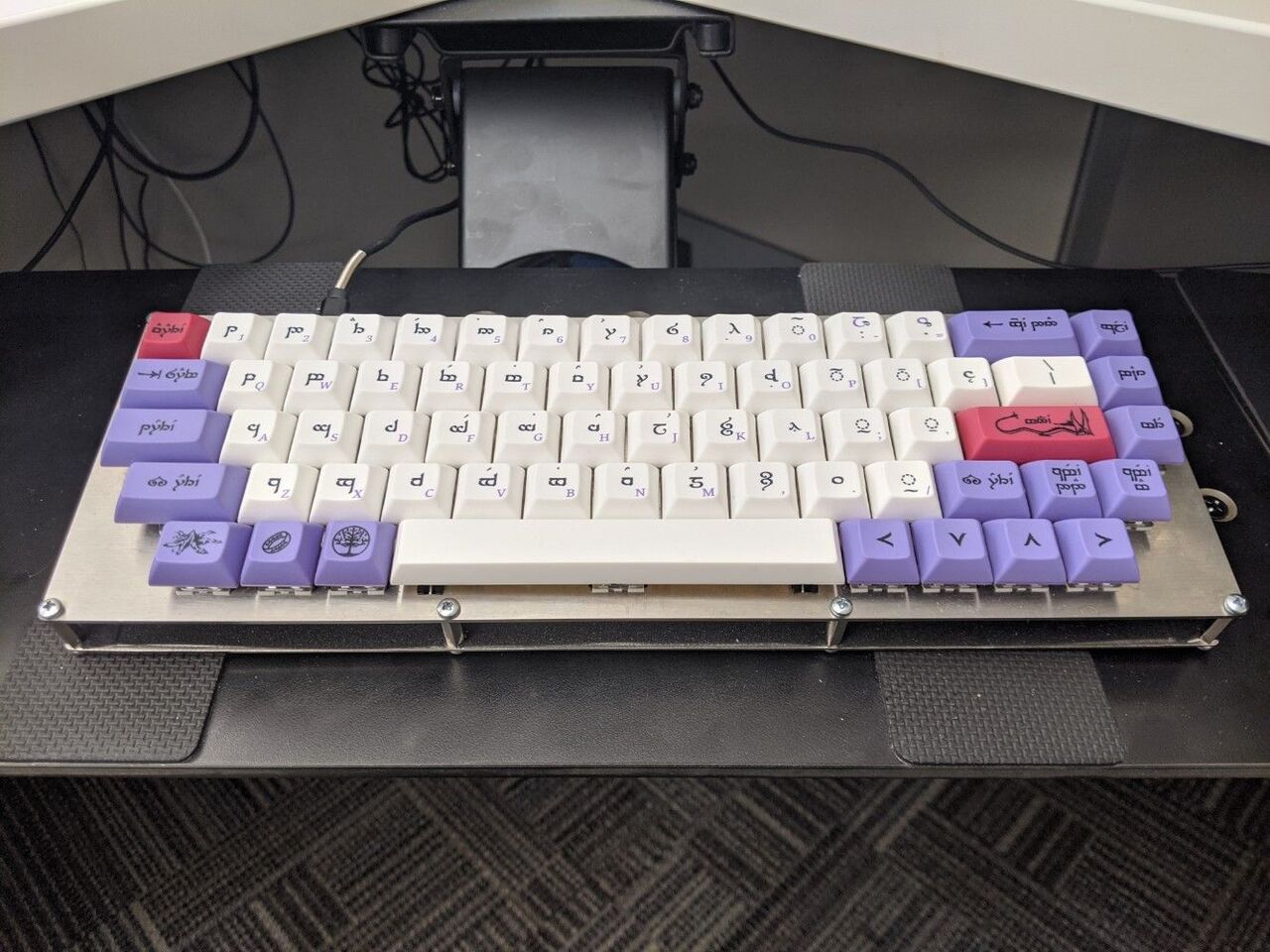- (https://b-ark.ca/ksKKwg)
I’m riding in the 2025 Enbridge Tour Alberta for Cancer, raising money for the Alberta Cancer Foundation, and have so far raised $2,744, exceeding my $2,500 goal and surpassing my 2024 effort!
Help me by donating here
And remember, by donating you earn a chance to win a pair of hand knitted socks!
- (https://b-ark.ca/YsAMKW)
My hand-wired keyboard upgraded with Matt3o Nerd caps. Yes, that’s Elvish!
- (https://b-ark.ca/ucCmGu)
So if this reply appears in the right place, and I think it will, I can confirm that fixing the source URL issue in my webmentions has resolved the problem and I can now successfully post replies to M.b from my blog. Phew! Thanks again!
- (https://b-ark.ca/cYugOi)
Just finished my 1st viewing of my favourite Christmas movie: “National Lampoon’s Christmas Vacation”. Happy 30th anniversary, Griswolds!
- (https://b-ark.ca/Wm4okI)
There’s something different about a nap on the couch next to your loved ones while a screen is on, as opposed to in silence alone in bed. I think it feels festive, somehow. It’s that post-holiday-meal vibe. It’s luxurious and drowsy and it was so pleasant that I think I might try to do it more often.
Ahh, so true! When I was a kid I fondly remember Sunday afternoons when a re-run of Star Trek would be on the TV while my dad napped on the couch. It’s now become one of my favorite things to do on the weekend: an episode of TOS playing as I snooze on the couch while my wife reads beside me.
Markdown all the things!
A post on self-hosted note taking with Markdown and some supporting tools.
I’ll be the first to admit that I’m a frequent user of tools like Google Keep, Google Docs, etc. But I’ve never been terribly comfortable with my dependency on those services. Yeah, obviously there’s the privacy concerns, but more fundamentally, I just want control over my data! It’s a heck of a lot harder to run “grep” over a set of notes in Google Keep…
Thematically, if you’ve been paying attention to this blog, you’ll notice this is part of a theme. Ultimately, I’m doing what I can to make sure I can manage and control my own information outside the walls of the common internet monopolies.
Now, quite a while ago I adopted vimwiki as my note taking method of choice. Before you get scared off, Vim is just a tool to enable a more fundamental idea: that personal information management should be built on the simplest possible tools and file formats, with the data under my own control.
In my case, I chose to focus on taking notes using plain text files, with a basic markup language that would allow me to write richer text and link those notes together.
When I first started doing this a few years ago I chose to stick with Vimwiki’s native markup, as it supported a few things out-of-the-box that Markdown, at the time, didn’t neatly support without using poorly supported extensions (I’m looking at you, checkboxes!) However, right around that same time, Github released a spec for their extensions to Markdown that plugged a lot of the holes that had concerned me, and since then support for these extensions has expanded considerably.
This caused me to revisit the issue and I concluded that a migration to Markdown made a lot of sense.
Continue reading...- (https://b-ark.ca/giOueG)
My Micropub endpoint Lillipub is up and running and ready for tweets! It ain’t pretty and there’s lots left to do, but it works!
- (https://b-ark.ca/c2giA8)
Jekyll+webmentions isn’t hard! I may write a blog post about it but I started with the instructions for this plugin: http://tiny.cc/5fvsgz
- (https://b-ark.ca/oc_yks)
Hah! I’m toying with posting more stuff to my blog and syndicating it here ala POSSE methodology. Also I’m bored. ;)
- (https://b-ark.ca/A6SsGe)
I’m really not cut out for these late night coding sessions anymore. But I’m having a lot of fun hacking jekyll-webmention!
- (https://b-ark.ca/Eq_qyA)
Next step in my indieweb adventures: building a Micropub endpoint. It’s alive!
Locked in Internet Silos
[“An intro post about my attempts to slowly pull myself out of internet silos so I can better control my data.”]
The Centralized Web
I don’t think I’d be making news by pointing out that the internet, today, is dominated by large, centralized services. While this centralization of the internet is a far cry from the original vision of peer-to-peer interactions and democratization, those services have, in many ways, enriched our lives by connecting friends and family, individuals and businesses, citizens and government.
But I also wouldn’t be making news by pointing out that those same services have a darker side, particularly those that would bill themselves as “free”. While ostensibly costing us nothing, these free services make billions collecting and monetizing our personal data while optimizing our use of those systems to enhance engagement. Worse, the data they collect, with or without our consent, is locked away outside of our control.
I know this. And yet I still find myself making use of many of these services, including:
- Google
- Email (Gmail)
- Storage (Photos, Drive)
- Calendar (uh… Calendar)
- Notes (Keep)
- Github
- Feedly
- Ravelry
And I’m sure many others besides.
Each of these services provides immense value! Instead of having to host email, or create my own offsite storage system, or manage my own git server, I can save time and effort by having someone else do the work for me.
However, in exchange, each of these services holds a piece of who I am. And I don’t control any of it.
Continue reading...- Google
- (https://b-ark.ca/cIACYu)
I can’t say I’m optimistic that the #indieweb is gonna really take off, but a man can dream…
- (https://b-ark.ca/2MKESc)
Yeah yeah, I’m posting to Twitter now. But it’s from my own Jekyll blog using the IndieWeb stack. So it’s hipster enough to be cool.
Moving to Jekyll
Well… I’m going to attempt something pretty major, here, and switch over my blog from my trusty Oddmuse instance to Jekyll… for better or worse.
There are numerous upsides to this. First, I’ve already built a lot of habits around taking notes using Vimwiki, and having recently made the switch to Markdown for that wiki1, having a consistent set of tools for personal and work note taking, as well as blog management sounds pretty attractive! Doubly so since I really enjoy the writing experience I’ve set up with Vim.
Second, this rebuild moves me to a well-supported set of tools that’s currently being very actively maintained. I’ve been a huge fan of Oddmuse for a long time, if only for its light weight simplicity, but its lost momentum over the years. Further, the dependency on a semi-custom markup, and the storage being in an oddball custom format, means I’m a little more tied down to its infrastructure than I’d like. Moving to pure Markdown means I get the simplicity of wiki-style markup without being tied to a specific technology platform.
Third, security. Static site generators are simpler, faster, and less complex to operate, and have a lower footprint for abuse.
That’s not to say there aren’t downsides! I’ve written a lot of content using custom plugins and markup, and I don’t know how I’m going to replace all that.
And, of course, there’s simply the act of transferring all that content.
But. I strongly feel this will be worth the transition.
And it gives me a project!
Update: And obviously I’ve moved! Of course, there’s lots of work left to do as I move into this new infrastructure. The site layout needs more work. I’d like an archive navigator. I need to enable some sort of commenting mechanism. But, so far so good!
And yeah, the tale of this entire transition and a rundown of my new toolset is probably worth a series of blog posts. Stay tuned!
-
This deserves a post of its own. This move has enabled me to do things like use Markor on my phone to share the same set of notes on both my laptop and my phone, which has had the ancillary benefit of basically killing Google Keep in my workflows. It’s not without its issues, and it’s not something I’d recommend to a casual user, but it’s pretty slick… ↩
-
Experiments in Automation
With the knock out success of my ttrss service rollout, I thought it might be fun to look into other self-hosted services that I might find useful. Now, let’s be very clear, this was, on its face, entirely a make-work project to give me something fun to do with my spare time. But the outcome has proven surprisingly useful!
It all began when I came across Huginn. Huginn is an open source implementation of the kind of service offered by IFTTT, Zapier, and I’m sure others (Microsoft Flow popped up while I was finding the links to those services). The general idea is that these services allow you to plumb or connect various other services together to effect an automated workflow. For example, you might receive tweets on one end and shoot them off to, say, a Slack channel on the other.
Okay, so what would I do with this?
Well, as a bit of background, I’m an avid reader of Matt Levine. Mr. Levine offers a newsletter that one can subscribe to that is delivered daily to ones email inbox. Notably, if you want to read this content on the Bloomberg website, it’s hidden behind a decided effective paywall that happens to defeat web scrapers. That means getting this content into my RSS feed isn’t directly possible.
But wouldn’t it be nice if I could take those emails, scrape out the content, and republish them to a private RSS feed that I could incorporate into ttrss?
Continue reading...

